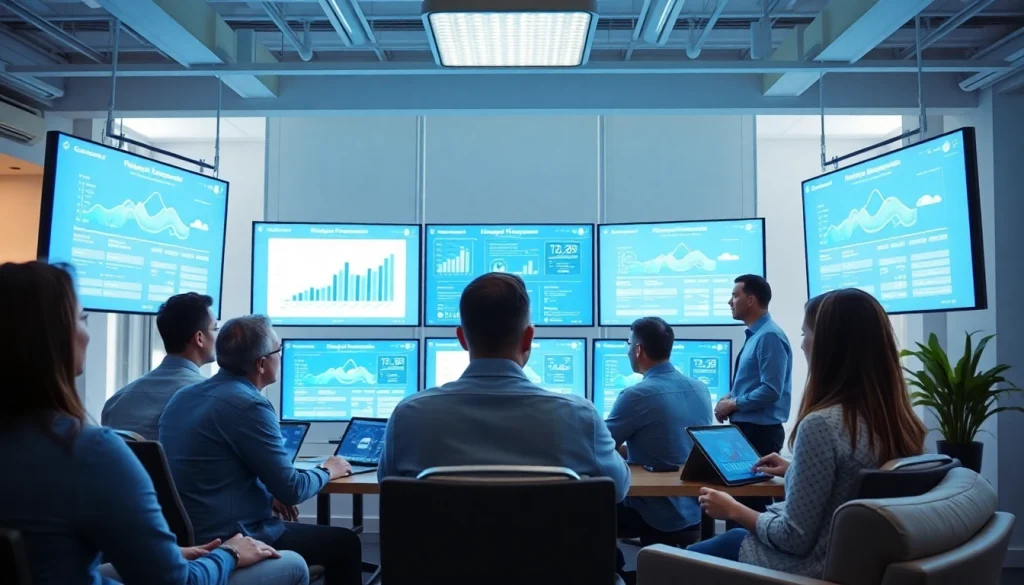Understanding the Role of Site Reliability Engineering Experts
In today’s fast-paced digital landscape, organizations are increasingly reliant on technology-driven solutions, necessitating robust system performance and reliability. This is where Site reliability engineering experts come into play. These professionals play a crucial role in ensuring that software applications remain operational, efficient, and scalable as demands grow.
What Site Reliability Engineering Experts Do
Site reliability engineering (SRE) experts essentially bridge the gap between the development and operations teams. Their primary responsibility lies in enhancing system reliability, availability, and performance. Unlike traditional operations teams, SRE professionals adopt a proactive approach, often leveraging software engineering techniques to solve infrastructure and operations challenges.
Their day-to-day functions typically include:
- Monitoring System Performance: SRE experts implement robust monitoring tools to observe system health and performance. By analyzing metrics and logs, they can identify potential issues before they escalate into significant problems.
- Incident Management: When system failures occur, SREs lead efforts to mitigate their impacts quickly. This involves root cause analysis and ensuring that services return to normal operation with minimal downtime.
- Capacity Planning: To accommodate future growth, site reliability engineers assess current system capacity and project future upgrades or scaling efforts necessary to meet user demands.
- Infrastructure Automation: SREs prioritize automating repetitive tasks to enhance efficiency. This can include deployment scripts, configuration management tools, and self-healing infrastructure.
- Collaborative Development: They also serve as integral members of development teams, working collaboratively to create services that meet reliability goals while fostering a culture of shared responsibility for performance.
Key Skills of Site Reliability Engineering Experts
The skill set of a site reliability engineering expert is diverse and multifaceted. Key competencies include:
- Programming Proficiency: A solid foundation in programming languages such as Python, Go, or Java is crucial for automating tasks and developing services.
- Systems Knowledge: SREs must understand operating systems, networking, and distributed system design to effectively troubleshoot and optimize infrastructure.
- Problem-Solving Aptitude: The ability to quickly analyze problems and think critically is vital, especially when mitigating incidents under pressure.
- Collaboration Skills: Given their role in bridging teams, SRE experts need to communicate effectively with developers, operations staff, and stakeholders.
- Monitoring and Incident Management: Expertise in tools and practices that support monitoring systems and managing incidents is essential, including familiarity with SLIs, SLOs, and error budgets.
Importance of Site Reliability Engineering Experts in Tech Companies
As organizations scale their technology stacks, the complexities of maintaining reliable systems increase. The role of site reliability engineering experts has become essential in ensuring high performance amid these challenges. Their importance can be understood through several key facets:
- Enhanced Reliability: SREs implement best practices in system design and operation, leading to increased uptime and customer satisfaction.
- Cost Efficiency: By automating processes and optimizing system performance, SREs contribute to reduced operational costs and improved resource utilization.
- Fostering Innovation: With reliability concerns managed effectively, development teams can focus on innovation and delivering new features more rapidly.
- Cultural Shift: SREs advocate for shared responsibility among teams, leading to a cultural transformation where developers and operations staff work towards the same reliability goals.
Core Principles of Site Reliability Engineering
The foundational principles that guide site reliability engineering are essential for achieving operational excellence. They encompass various strategies and methodologies integral to the SRE discipline.
Service Level Indicators and Objectives
At the heart of SRE practices are Service Level Indicators (SLIs), Service Level Objectives (SLOs), and Service Level Agreements (SLAs). SLIs are measurable metrics that indicate how well a service is performing. These metrics often include response times, service uptime, and error rates.
Building SLOs involves defining acceptable performance levels for these indicators, providing a target for teams to strive towards. For instance, an SLO might specify that a service must be available 99.9% of the time. Establishing these performance benchmarks ensures that teams have clear standards and can prioritize their efforts effectively.
Automation and Monitoring Practices
Automation is a cornerstone principle in site reliability engineering. SRE experts utilize automation not only for repetitive tasks but also for provisioning infrastructure and orchestration of application deployments. With tools such as Terraform and Kubernetes, teams can achieve greater efficiency and improved deployment times.
Monitoring, on the other hand, is facilitated through observability frameworks that provide insights into system health. Utilizing tools like Prometheus or Grafana, SREs can visualize performance data, identify anomalies, and maintain service reliability over time.
Incident Response Strategies by Site Reliability Engineering Experts
Incident response is a critical component of SRE. When incidents occur, SREs follow structured protocols to mitigate risks and restore service quickly. This often includes:
- Postmortem Analyses: After every incident, SREs conduct reviews to analyze what went wrong, understand the contributing factors, and document lessons learned.
- On-call Rotation: SREs typically engage in on-call rotations to ensure that there are trained individuals available to respond to incidents 24/7.
- Runbooks: Creating detailed runbooks enables faster incident resolution and ensures that knowledge is retained regardless of personnel changes.
Best Practices for Collaborating with Site Reliability Engineering Experts
Collaboration between site reliability engineering experts and other teams is paramount for achieving optimal results. Effective integration enhances performance and service quality across the board.
Integrating SRE into Development Teams
Embedding SREs within development teams fosters a collaborative atmosphere that promotes shared ownership of reliability. This can be accomplished in several ways:
- Cross-functional Teams: Forming teams that include both SREs and developers ensures a holistic approach to product development and operational excellence.
- Regular Communication: Engaging in daily stand-ups or weekly syncs helps align objectives and keeps everyone informed about ongoing performance initiatives.
- Feedback Loops: Establishing continual feedback mechanisms allows SREs and developers to learn from each other’s experiences and improve both service performance and user satisfaction.
Maintaining Effective Communication
Effective communication is fundamental to the success of SRE initiatives. This involves not only sharing technical information but also ensuring that everyone is on the same page regarding reliability goals.
Some best practices include:
- Documentation: Keeping up-to-date documentation that details procedures, metrics, and performance expectations supports transparency and knowledge sharing.
- Real-time Monitoring Dashboards: Implementing dashboards visible to all stakeholders allows teams to monitor performance in real time and fosters accountability.
- Unified Reporting: Establishing a common reporting format for outages and performance issues enhances clarity and ensures that necessary information is communicated effectively within teams.
Setting Realistic Expectations with Site Reliability Engineering Experts
Finally, it is essential to set realistic expectations when collaborating with site reliability engineering experts. This includes acknowledging that while SREs can significantly improve reliability, they cannot guarantee 100% uptime. Teams should:
- Define New Norms: Understand that with continued growth, SRE practices will evolve, and reliability expectations may shift accordingly.
- Balance Innovation and Reliability: Encourage innovation while ensuring that any new features or changes do not compromise system stability.
- Collaborative Goal Setting: Work together with SREs to align service goals with business objectives, ensuring both reliability and growth.
Case Studies of Successful Site Reliability Engineering Implementations
Real-world implementations of site reliability engineering provide valuable insights into its effectiveness and the tangible benefits it can deliver.
High Profile Projects Led by Site Reliability Engineering Experts
Several organizations have successfully implemented SRE practices to enhance their reliability. For instance, a prominent e-commerce platform adopted an SRE approach that led to a 30% decrease in incident resolution time and a significant reduction in downtime.
Through structured incident management and routine postmortem analyses, teams were able to identify recurrent issues and address them proactively, showcasing the importance of learnings from past experiences.
Measuring Success: Metrics and KPIs
Measuring the success of site reliability engineering initiatives is critical for continuous improvement. Metrics and KPIs such as:
- Mean Time to Recovery (MTTR): Measuring the average time taken to restore service after an incident, MTTR is a key indicator of incident response efficiency.
- Availability: Typically expressed as a percentage (e.g., 99.9% uptime), availability metrics help assess the reliability of services over time.
- Error Rate: Monitoring the frequency of errors helps teams understand the stability of their systems and identify areas for improvement.
By assessing these metrics, organizations can gain actionable insights and make informed decisions about where to focus their SRE efforts.
Lessons Learned from Site Reliability Engineering Experts
One of the most significant takeaways from successful SRE implementations is the importance of a blameless culture when analyzing incidents. By fostering an environment where team members feel safe discussing mistakes, organizations can improve learning and drive performance.
Additionally, continuous education and training for SRE professionals ensure they stay current with the latest tools and technologies, ultimately leading to better system performance and reliability.
The Future of Site Reliability Engineering
As technology continues to evolve, the field of site reliability engineering is also undergoing transformations driven by emerging trends and technologies.
Emerging Trends in Site Reliability Engineering
Notably, the rise of artificial intelligence and machine learning is influencing SRE practices. Automation powered by AI can streamline monitoring, incident detection, and response times, allowing SRE teams to focus on more strategic initiatives.
Moreover, the adoption of cloud-native architectures necessitates a shift in SRE practices, emphasizing the need for expertise in containerization and microservices management.
The Evolving Skillset of Site Reliability Engineering Experts
To remain effective, site reliability engineering experts must expand their skill sets continually. This includes familiarity with emerging technologies, data analytics, and even soft skills to enhance collaboration and communication.
As SRE practices mature, the fusion of development and operations will demand professionals who are not only technically proficient but also adept at fostering collaborative cultures within their teams.
Preparing for the Next Generation of Site Reliability Engineering
Organizations must prepare for the next generation of site reliability engineering by investing in training and support for their teams. Emphasizing continuous learning ensures that SRE experts can adapt to changing technologies and practices effectively.
Furthermore, fostering a culture of innovation and experimentation within their teams can lead to improvements in service reliability and performance, driving overall business success.



